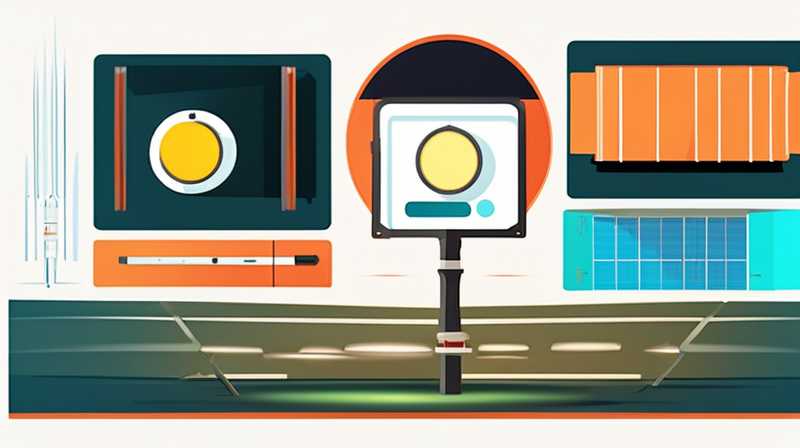
Repairing solar headlights involves a systematic approach to diagnose and fix common issues. 1. Check the solar panel for dirt or damage, 2. Inspect the battery for corrosion or failure, 3. Examine the LED for functionality, 4. Test the wiring connections for continuity. A detailed inspection of the solar panel is essential as it plays a vital role in energy collection. Often, dirt, debris, or shade can significantly reduce efficiency. Cleaning the panel with a soft cloth and ensuring it receives adequate sunlight can lead to improved performance.
1. SOLAR PANEL INSPECTION
The solar panel of the lights deserves careful consideration as it serves as the principal component responsible for gathering sunlight during the day. Whether it is mounted on a wall or positioned on the ground, the orientation and cleanliness of the panel will directly influence its energy conversion efficiency. Dust or grime buildup can obstruct sunlight, leading to insufficient charging of the batteries. Regular cleaning is key to maintain its effective operation.
Furthermore, inherent environmental factors, like extreme weather conditions, can inflict physical damage upon the panel. Cracks or breakage can notably hinder its capacity to absorb sunlight. Consequently, it is prudent to conduct visual inspections periodically and replace any damaged panels to uphold uninterrupted functionality.
2. BATTERY EXAMINATION
Following the solar panel’s inspection, attention must shift to the battery, which stores the energy collected by the solar panel. Various types of batteries, including rechargeable NiMH or Lithium-ion, may be employed in solar lights. Over time, batteries can experience wear and tear, leading to reduced capacity or complete failure. Observing the battery for signs of corrosion or swelling can offer immediate insight into its condition.
When conducting a detailed evaluation, it is essential to test the battery voltage using a multimeter. If the voltage falls below the manufacturer’s stated capacity, it typically suggests that the battery functions inadequately, necessitating a replacement. Selecting a battery compatible with the solar headlights significantly enhances the efficiency and longevity of the entire lighting system.
3. LED FUNCTIONALITY
The light-emitting diode (LED) is integral to the operation of solar headlights, providing illumination after sunset. Should the headlight fail to light, it may be indicative of an LED issue. Similar to other components, LEDs can degrade over time, and their efficacy might diminish.
Testing the LED’s functionality requires some expertise but can often be accomplished with a simple test circuit. By connecting the LED to a direct power source, it can be established whether the light source is functioning correctly. If the LED remains unlit after the direct connection, it is likely damaged and must be replaced. Utilizing high-quality replacements will ensure that brightness is maximized.
4. WIRING CONNECTIONS
A comprehensive inspection of wiring connections is crucial, as any loose or corroded wires can disrupt the power flow between components. Over time, rodents or weather exposure can damage wiring, which could lead to inconsistent lighting performance. Checking for continuity using a multimeter can reveal broken connections that impede proper functionality.
In cases where wiring issues are prevalent, consider rewiring the affected areas with appropriate materials and techniques. Utilizing weather-resistant cables contributes to increased durability. Properly sealing connections can prevent moisture ingress, safeguarding the system’s integrity.
FREQUENTLY ASKED QUESTIONS
HOW OFTEN SHOULD SOLAR HEADLIGHTS BE MAINTAINED?
Maintenance of solar headlights should ideally be conducted twice yearly, particularly before and after the winter months. Residue from the environment may accumulate during seasonal changes, affecting the efficacy of solar panels. Additionally, regular inspections ensure that any components showing wear are replaced promptly, thereby prolonging the overall lifespan of the system.
CAN SOLAR HEADLIGHTS WORK IN WINTER OR CLOUDY WEATHER?
Solar headlights can function in winter or cloudy weather, albeit at reduced efficiency. During these conditions, solar panels will collect less sunlight, leading to weaker battery charging and diminished illumination. Using high-quality solar panels designed for low-light conditions can enhance performance. Moreover, positioning panels where they receive maximum sunlight during the day is crucial for ample energy collection.
WHAT TYPES OF BATTERIES ARE BEST FOR SOLAR HEADLIGHTS?
Several battery types are suitable for solar headlights. Among the most common are Nickel-metal hydride (NiMH) and Lithium-ion. NiMH batteries are preferred due to their environmental friendliness and cost-effectiveness, while Lithium-ion batteries are prized for their longevity and efficiency. Selecting a battery with appropriate specifications ensures compatibility, performance, and durability in the system.
FINAL THOUGHTS
Successfully repairing solar headlights hinges on methodical evaluation and troubleshooting of the components involved. Each crucial aspect—from the solar panel through the battery to the LED and wiring—plays an essential role in ensuring optimum performance. Regular inspection and maintenance not only foster superior functionality; they also extend the lifespan of the system, resulting in significant savings over time.
Address potential complications proactively by establishing a routine that includes cleaning, testing, and replacing parts as necessary. When faced with irreparable damage, investing in quality components will pay dividends down the line. Carefully understanding the intricacies involved in solar technology empowers consumers to make informed decisions and execute repairs effectively. By empowering oneself with knowledge of how to maintain and repair solar headlights, one can significantly reduce reliance on external services and enhance self-sufficiency.
Ensuring solar headlights remain operational contributes positively to environmental sustainability, reducing reliance on traditional electricity sources while minimizing carbon footprints. By promoting energy-efficient solutions within the home or garden, individuals can embrace a more ecologically responsible lifestyle. Ultimately, the journey toward maintaining solar headlights not only represents self-reliance but also participates in a broader commitment to renewable energy and sustainable living, aligning personal choices with a collective effort toward a healthier planet.
Original article by NenPower, If reposted, please credit the source: https://nenpower.com/blog/how-to-repair-solar-headlights/


